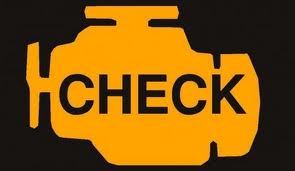If your vehicle is a 1996 or newer model, it comes equipped with an On-Board Diagnostics System (OBD II). This system is designed to catch emissions problems before they become a major concern.
- OBD alerts you to conditions that waste fuel, shorten engine life and result in potentially expensive repairs.
- OBD lets you know your vehicle is contributing to unhealthful air by emitting excess pollutants.
A vehicle will not pass an emissions test when the check engine light is on. If the battery has been disconnected or the trouble codes erased, you will have to drive the vehicle under varying conditions for up to one week before it will pass. Remove any device that monitors your driving habits before a test and replace it afterwards.
Be as bright as this dashboard light!
Take your vehicle to a qualified OBD II repair shop when you see the Check Engine light. A flashing light indicates a severe problem which could damage the catalytic converter.
Emissions Tests with OBD II
Your yearly smog check on 1996 and newer vehicles is done through OBD II, rather than the older two-speed or “tail pipe” test. OBD II is more accurate than the two-speed test and less costly than the dynamometer tests used in some other states. The test itself is also much faster. Stations can often complete an OBD II test in five minutes or less.
The emissions technician will scan your Vehicle Identification Number on the driver’s door using a bar code reader. The technician will then plug a cable from the analyzer into your vehicle’s OBD computer. There is no other connection or probe. Not only does this quickly indicate whether your vehicle passes, it also helps the technician pinpoint any malfunctions.
Nevada emissions inspections stations are equipped with advanced analyzers that send emissions test results to the DMV in real time. Simple screens walk the operator through the test. Many stations also offer registration renewals once you have completed the test.
OBD II is the lowest cost, most accurate inspection for newer vehicles. Vehicles 1995 and earlier will continue to be tested under the two-speed method.
Do’s and Don’ts
DO take your vehicle in for service right away if the “Check Engine” or “Service Engine Soon” light comes on and stays lit. This light should not be ignored. Even though the vehicle might seem to be running just fine, there is a problem which has potential to increase emission levels.
One item you can check easily is the gas cap. A loose or broken gas cap will cause the Check Engine light to come on. The light go off by itself once the gas cap is properly tightened.
Sometimes when a Check Engine Light comes on the vehicle’s engine computer will go into a “back-up” or “limp-home” mode. This allows the vehicle to continue operating until repairs can be made. Back-up or limp-home modes are not the most emission or fuel efficient way for the vehicle to operate. The problem needs to be repaired.
DO check with your local dealer to find out if your vehicle is covered by warranty or recall if a problem occurs with your vehicle’s OBD-II system. Expensive emission components could be covered under warranty for up to 8 yrs or 80,000 miles, whichever occurs first.
DO get your annual emission test early. Remember, the test is valid for 90 days. If the emission test finds a problem with your vehicle, you will have some time to take care of the problem before your registration expires.
DON’T drive your vehicle if the “Check Engine” or “Service Engine Soon” light is flashing. A flashing light means that a problem exists that may cause damage to expensive emission control systems. So, get your vehicle to a repair facility immediately. A ruined catalytic converter can cost thousands of dollars to replace.
DON’T take your vehicle in for an emission test right away if you just replaced a battery, or if the existing battery had gone dead, was disconnected or has been cranking slowly. If a battery drops below five volts the vehicle’s computer memory will be lost. Your vehicle will not pass the test and will be “Rejected”. The vehicle will need to be driven under varying conditions for up to one week in order for the OBD-II system to run all of its on-board diagnostic tests.
If your license plates are expired, or will expire within the week, go to your nearest DMV office and request a movement permit. It is very rare to find a vehicle that will not be ready for emission testing after a week’s normal driving. In the event you have any questions, please contact the Department of Motor Vehicles Emission Control Lab in your area.
DON’T clear any Data Trouble Codes using a scanner, hoping to pass the emission test. If you erase the Data Trouble Codes and then take the vehicle in for emission testing right away, it will be “Rejected”. Clearing the Data Trouble Codes erases all of the OBD-II system’s memory settings. The vehicle will need to be driven under varying conditions for up to one week. Additionally, erasing the codes may hide problems and make it more difficult to diagnose and fix your vehicle.
DON’T take the vehicle in for a test if you have a device that monitors your driving habits plugged in to the connector below the dashboard. You must remove the device and replace it after the test. Emission stations are required to fail the vehicle if such a device is plugged in.
